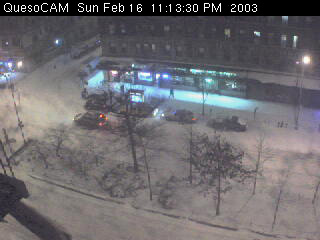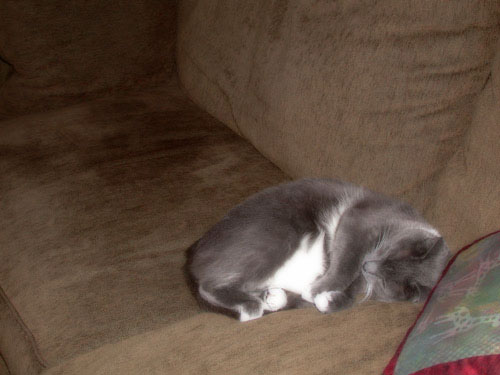I’m glad to note that SpamAssassin 2.50 has been released, bringing Paul Graham’s now-famous Bayesian filtering idea to the world of detecting unsolicited email. The new version also brings improved rules for detecting the telltale signs of bulk mailings, as well as a better way of modifying mail it suspects is spam (it encloses the original mail as an attachment, and then changes the main message to a preview plus an explanation of why it thinks the mail is unwanted). Mostly, I’m happy that the release made it into the world at all, given Deersoft’s acquisition by Network Associates last month. Here’s hoping to continued open source releases…
I don’t think I can put into words how cool I think this project is. James Meehan strung together a helium-filled balloon, a radar reflector, a Garmin GPS receiver, an Aiptek Pencam, a ham radio, and a computer system built from off-the-shelf components, and launched it all as an amateur weather balloon. It travelled nearly 80,000 feet into the air, sending reports back the whole time; the reports contained location information, allowing James and his team to track it while it was in the air, find it when it landed, and retrieve all the pieces (including the pictures taken by the camera). He called the experiment “Balloon 1.0,” which leaves me optimistic that there’ll be a few more iterations to come.
Shannon and I snuck up to Boston last night, a planned-at-the-last-minute trip to scout out the lay of the land for my eventual move this summer. It’s too early to start looking at actual apartments, so we spent today just driving and walking around neighborhoods — Brookline Village, Coolidge Corner, Jamaica Plain, Longwood — trying to feel whether or not I could call any of them home. A lot of the dread that I’ve been feeling over the past few months about the move is rooted in the fact that I’ve built up a lot of comfortable stasis in New York; to wit, I’ve spent college, medical school, and now residency at the same institution, I’ve lived in the same amazing apartment for nearly eight years, and my entire family is arranged neatly around me on the island of Manhattan. Moving away from all that isn’t easy, so the goal of this weekend was simply to begin getting a feel for the new life I’ll be starting in July, and maybe to see that there are places here to plant a new root or two. A vibrant neighborhood, a few beautiful apartment buildings, a ride past my new hospital on the T, a great dinner with friends — today, all of these things helped me take a few steps towards being ready to get on with things. None of it makes it any easier to leave New York, but all of it makes it easier to come to Boston, and there’s nothing but good in that.
Thanks to Eric Lacombe, the 2nd annual SxSW kickball game has a brand spankin’ new logo. Andre Torrez recommended him to me, after the great job that Eric did on Andre’s logo; I’m happy to say that he accepted, and the game’s all the richer because of it. Go check out the loot shop, complete with shirts and whatnot with Eric’s new logo, and buy stuff to support the game!
The Step 3 is now complete, and I couldn’t be more relieved; for some reason, studying for them was way more annoying to me than it should have been.
The last segment of the exam today consisted of nine individual clinical vignettes, and my job was to work from presentation through diagnosis and treatment. The exam is administered via an application that let me write orders, perform procedures, studies, and tests, call consults, and generally do what I’d do if I were actually caring for a patient. An artificial intelligence engine interpreted my requests, and asked for verification when it needed it; the system also enforced a virtual timeline, with results coming back in the same time period that they would have in the real world, and complications unexpectedly popping up as the workup and treatment took place. Aside from a pretty terrible interface and painfully slow responses at times, the application was cool, and I’m excited to see that medical testing is moving to the next level.
Now, for the Massachusetts licensing application…
I’m starting to get excited about SxSW 2003, if only because of all the activity in the weblog arena lately. There’s Google buying Pyra, AOL sniffing around the periphery, the debut of TextPattern, the announcement of Movable Type Pro, the promise of Meg and Nick’s collaborative Lafayette Project, and whole slew of other, smaller interesting tidbits. Now, I know that SxSW is about a hell of a lot more than weblogs, but part of my connection to the conference is through my personal site. As my medical life exerts more and more pressure on my site and database design life, QDN remains the excuse that I use to justify the amount of time I spend learning new programming languages, content management systems, web standards, and design skills. Last year, I was glad to get a chance (if only for two days) to listen to people who have worked wonders in the world of interactive media, and I feel like I came away from the conference with a good deal more knowledge, not to mention the buckets of respect for the collective intellect that’s devoted to building a better web. If all the positive energy in the weblog world this year has any meaning, I’m eager to get back to Austin this year.
(Of course, I’m also excited about Kick 2003, but that’s a post for later this week…)
One day of the USMLE Step 3s down, one more day to go…
(And, for the record, one of the big reasons I decided to go into pediatrics was that I much prefer patients whose presentations don’t start with drug or alcohol abuse and then devolve into a list of a dozen prior medical problems and an even longer list of current medications. Keeping track of the threads of illness in the adult medicine questions is getting tough on my pediatrician brain!)
I mean, I know that we were expecting snow tonight, but holy crap did it start snowing in a hurry!

When Shannon and I walked into my parents’ apartment tonight for dinner, it was crisp and cold out, with nothing in the air but the mist coming off our breath. About fifteen minutes later, you could make out the barest of little snowflakes silhouetted against the glare of the streetlights below; within a half an hour, the sky was full of snow, blowing parallel to the ground and getting caught in swirling eddies around the trees in Park Avenue’s median. By the time our bellies were full, the roads were covered curb-deep, and we decided to try to get back across town. Somehow, it only took two or three minutes for Shannon and my sister to flag down the only cab that wasn’t either already taken or fishtailing its way across the unplowed streets (or both). The trip back to the Upper West Side was slow going, but we went through the Park, and the view of the trees and rock walls covered with flawless snow was more than worth the time it took. And while the sidewalks of the Upper East Side were mostly deserted, those over here have a few curious souls on them, showing their children the deep snow and enjoying the magical white blanket that comes but a few times a year.
The Commerce Department announced yesterday that it was expanding the eligibility for .edu domain names to all U.S. educational institutions which have been accredited by an agency on the Department of Education’s list of recognized accrediting agencies. This means that a whole host of vocational schools — massage therapy schools, midwifery training institutions, cosmetology programs, and Montessori schools, to name a few — are joining the .edu neighborhood. The change has come with a bit of complaining, of course, mostly from the elder elite who feel that .edu should remain the province of the upper crust; a retired Princeton administrator was actually quoted on the AP wire as saying, “Somebody who goes six months to a beauty school, I would not consider in the same league as somebody who’s even been two years at a community college…. There’s too much dumbing down already.” I have to ask: are there really people who judge a person’s academic worth on whether or not his educational email address had .edu at the end? (And as if a Columbia guy like myself needed another reason to look down on Princetonians…)
I think that I’m big enough to admit to the fact that tonight, while deleting the 2600 unsolicited email messages I have received in the past 8 days, I totally failed to appreciate the irony of the three messages entitled “Tired of Deleting Junk eMail?”.
I can’t wait for there to be a tenable way to stem the tide of spam.
A few collected links about the Hudson Railyards, which was pictured behind Alison on our High Line jaunt and is the proposed site of a massive development project:
- New York City’s project page for “Far West Midtown” (known to the rest of us New Yorkers as either Hell’s Kitchen or Clinton), explaining the opportunities represented by the neighborhood and laying out a framework for development;
- the official site of the New York City 2012 Olympic bid, including a venue and transport plan that includes a new stadium over the Railyards, as well as an expanded convention center venue, shopping centers, hotels, and a new mass transit center;
- a perspective piece from New York Metro, describing the Olympic bid as a catalyst for the development not only of the Railyards, but also of other neglected areas of the five boroughs, all on a scale comparable to Robert Moses’s makeover of the New York metropolitan area;
- a Gotham Gazette article that, in part, describes the NYC2012 plan for financing the Hell’s Kitchen redevelopment, Tax Increment Financing (selling bonds that are used to develop the land, and paying them off with the anticipated increase in property values and tax revenue);
- the other side of the Olympic Stadium argument, from the always-awesome hellskitchen.net;
- a proposition by Virginia Fields (PDF), Manhattan Borough President, to turn the entire tract into a series of parks, low-density housing, schools, and office space (e.g., a neighborhood);
- lastly, a competition, sponsored by Friends of the High Line, to design the public park space that will sprout from the abandoned railbed that runs around the Railyard and down into Greenwich Village.
Today, the scientific part of my brain was in control at the exact time necessary to help me put my finger on what it is I hate most about the Washington Post website’s idiotic, intermittent survey: it collects terrible data.
I use many computers in the course of a week. I have a half-dozen machines in my apartment, another one at Shannon’s, one on my desk at the hospital, and two on my desk at the magazine for which I do occasional work. There are also a dozen computers on every floor of the hospital, and a dozen more computers at my outpatient clinic. Add to that the two computers at my parents’ home, the one at my brother’s apartment, and the one at my sister’s, and of course, don’t forget the umpteen public terminals out there — at libraries, airports, Internet cafes, conference centers, and hotels — that I’ve used on occasion. We’re talking about a lot of machines here, and I’m reasonably certain that the Washington Post has counted me as a 29 year-old New York City male on each and every one of them. According to their database, there are dozens of keyboard-happy Manhattan twentysomething men banging down their virtual door; their automated ad generator spends countless cycles of processor time dreaming up sales pitches for bagels with schmears, spacesaving hardware projects, and Chinese take-out. And given my penchant for reinstalling operating systems (or, at the very least, clearing out my web browser cache and cookies) every now and then, the WP site counts me again and again and again.
I used to think that the best answer was to give them false information — once an octagenarian woman from Burkina Faso, the next time a months-old baby boy from the French island department of Reunion. The survey attempts to assuage those of us who hate filling out the form over and over by promising that the survey will help them better know their readers, improve the website, and serve better ads; it became fun to try to figure out what their marketing drones were going to choose as the best products to push to 110 year-old Micronesians. It eventually became easier to just enter my real information, though, but today I came to the realization that repeatedly doing so may be the best way of all to poison their database.
Since I was nominated for a PhotoBloggie today (the Best Photo Essay on a Blog category, for the High Line pictures), and I walked out of the hospital into a surprise snowstorm (well, a surprise to me, in any event), I figured that a photo might be in order:

Even that picture doesn’t do the snowstorm justice; the flakes are plump and airy, slowly wafting down and in no rush to join their colleagues on the street below.
Whenever I stay at Shannon’s apartment, my morning walk to the subway takes me down a long crosstown block that has angle parking. Every single morning that I walk that stretch of Manhattan pavement, there are at least three specific cars that are illegally parked, a black Lincoln Continental that’s nosed into a fire hydrant, a maroon Bonneville that’s up against another fire hydrant, and a dark grey Cadillac-type sedan that sits in a zebra-striped loading zone. All three cars have laminated signs on the dashboard identifying their drivers as members of the NYC police force.
The short walk from my apartment to Shannon’s takes me past the neighborhood police and fire stations, and on the block, there are invariably about a dozen cars, trucks, and SUVs parked illegally — in crosswalks, against fire hydrants, double- and triple-parked, blocking driveways — all with either shields or laminated signs on the dashboards. The volume of illegal parking on the block has made the extra-wide sidewalks into valid driving lanes, used to escape parking spots that remain blocked for hours and hours; it has also caused otherwise-legal parkers to leave their car six or eight feet out from the curb, so that there’s no room for someone to illegally block them in.
I gotta say, as an occasional New York City driver, count me in as strongly in favor of the aggressive enforcement of this city’s parking laws, but make sure that the new swarms of traffic cops ticket everyone, not just us hoi polloi who don’t have a badge.
If you’re looking for a real, in-depth look at Howard Coble’s idiotic defense of Japanese-American internment camps, head over to Is That Legal (starting with the February 5th entries). Eric Muller provides informative and well-researched background on the camps, from their origins in biased research done by the Secretary of the Navy to the voices of reason that were silenced in favor of racist, reactionary politics. He also puts a good deal of work into debunking Coble’s attempt to claim that internment camps were primarily for the protection of Japanese-Americans, and sent the explanation to Coble’s office as an added bonus.
I can’t believe that this schmuck just won himself another term in office.
What do you think makes an applicant more attractive to a college, getting great grades and working hard in an internship, or having a propensity for filing lawsuits against your school demanding better grades? Does the fact that the lawsuit is over a grade given by the applicant’s mother change the answer at all? How about the fact that the lawyer representing the student is that same aforementioned mother?
What a depressing piece of news: “Even if flight controllers had known for certain that protective heat tiles on the underside of the space shuttle had sustained severe damage at launching, little or nothing could have been done to address the problem.” Of course, there’s part of me that hopes that, had NASA or the orbiter crew known about the damage, another option would have presented itself; after all, I can’t imagine that anyone would have been able to predict the sequence of events that led the Apollo 13 astronauts to survive their ordeal in space. Given the amount of national grief, it seems that had anyone known that the lives of the seven astronauts were at such risk, nothing would have been spared to get them down.
I have to thank Rafe for pointing to Kurt Vonnegut’s rant in this week’s issue of In These Times. It’s a great read, mostly because it’s a rare example of a public person expressing heartfelt, passionately-held beliefs without really giving a crap about what other people think. (It’s the same reason why Bulworth, and Courtney Love’s now-famous letter, worked.) Of course, it’s also cool because it’s entertaining, a fact which stands in stark contrast to Vonnegut’s most recent books. I only hope that we all can be this entertaining when we’re 80.
Just in case you were wondering, Dan Chaon’s story on McSweeney’s, “The Bees,” is a near-perfect description of night terrors. I only hope that Frankie’s pediatrician told his parents this…
Berkeley’s computer science department has provided yet another breakdown of last week’s SQL Server worm, this one more epidemiological than technical. One of the most impressive parts of the report is a Wargames-like graphic that shows the reach of the worm in its first 30 minutes of life; there are also good graphs showing both the packet traffic generated by the worm and the rapid decline in its traffic as system and network administrators responded. (Something that particularly interests me is that the traffic analysis was done in a “tarpit” network — a network that’s used only to collect data on incoming, unrequested packets like those used in virus or worm attacks — at the University of Wisconsin Advanced Internet Lab.) One of the big lessons to take from the data is that, with a rate of spread that quick and a penetration into networks that deep, a more malevolent worm could cause a hell of a lot of damage.
Since most of the new coverage of the Columbia disaster is perseverating on potential causes and the presence of the first Israeli astronaut, I’ve been surfing in an attempt to find out more about the mission. One thing I discovered that’s of interest to me is that STS-107 was possibly the last pure science mission for the Space Shuttle program in the forseeable future. As I mentioned earlier, Columbia was the first, and heaviest orbiter, and prior to its rehabilitation over 2000 and 2001, it was unable to reach the orbit of the International Space Station, and was perfect for science missions. Now, the future schedule for the Shuttle program is packed with ISS contruction missions, and science has mostly been displaced.
There were over 80 scientific experiments aboard Columbia, all of which were designed to exploit microgravity in the study of how cells, flames, organisms, magnets, and basic human biology operate. In addition to the crew, there were rats, garden orb weaver spiders, silkworms, fish, carpenter bees, and harvester ants on the orbiter, and countless colonies of human tissue cells and bacteria. There are factsheets for many of the experiments available online; there’s also a website, currently either down or overloaded, for the Space Technology and Research Students (STARS) Academy, a research organization that developed and sponsored many of the research projects. I have no idea how much data was gathered and transmitted back from these experiments, but there’s undoubtedly a great deal more data that was lost in the disaster.
Florida Today is the best source of collateral information on the mission that I’ve found; the site also has an amazing journal that has been kept for the duration of the landing and aftermath.
Tragedy strikes the U.S. space program again, for the first time since 1986. The Columbia orbiter was the first in NASA’s fleet, delivered in 1979 and first launched in 1981; it has gone through a retrofit and two complete overhauls since, though, and was most recently returned to service in early 2002. It also was the only orbiter originally not involved in the building of the International Space Station, since its weight made it impractical for carrying the necessary heavy equipment and modules into orbit. It came out of its last overhaul lighter and capable of reaching the ISS, however, and was scheduled to start helping with construction in November. (Interestingly, one crew member of that November launch was supposed to be Barbara Morgan, who was Christa McAuliffe’s backup on the fated Challenger mission.)
Last time the U.S. lost an orbiter, launches were postponed for nearly two years while the investigation was completed and modifications were made. This time, there are two big differences, and unfortunately, it seems to me that they conflict with each other. First, there doesn’t appear to be any video (or other precise witness information) about the Shuttle failure; after the Challenger disaster, the video appears to have played an almost critical role in the investigation, and I wonder what its absence will mean to the length of time it will take to determine what happened this morning. Second, and more importantly, we have astronauts up on the space station right now, and they’re supposed to be retrieved and replaced next month. I wonder if we’ll rely on Russia’s Soyuz transporter in the interim (since, as far as I know, it’s the only option available to us for manned spaceflight to and from the ISS). (Funny — while I was writing this, Time published a question-and-answer piece that ended with the same conclusion.)
What a terrible disaster.



